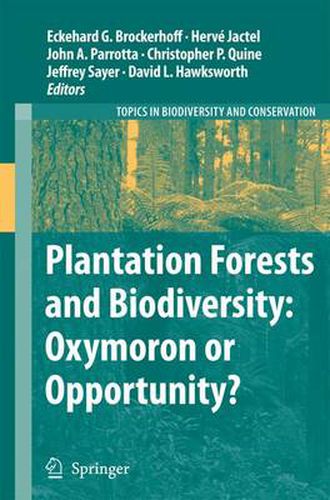Readings Newsletter
Become a Readings Member to make your shopping experience even easier.
Sign in or sign up for free!
You’re not far away from qualifying for FREE standard shipping within Australia
You’ve qualified for FREE standard shipping within Australia
The cart is loading…






This title is printed to order. This book may have been self-published. If so, we cannot guarantee the quality of the content. In the main most books will have gone through the editing process however some may not. We therefore suggest that you be aware of this before ordering this book. If in doubt check either the author or publisher’s details as we are unable to accept any returns unless they are faulty. Please contact us if you have any questions.
1 Plantation forests and biodiversity: Oxymoron or opportunity? Forests form the natural vegetation over much of the Earth’s land, and they are critical for the survival of innumerable organisms. The ongoing loss of natural forests, which in some regions may have taken many millennia to develop, is one of the main reasons for the decline of biodiversity. Preventing the further destruction of forests and protecting species and ecosystems within forests have become central issues for environmental agencies, forest managers, and gove- ments. In this di?cult task science has an important role in informing policy and management as to how to go about this. So how do industrial and other pl- tation forests ?t into this? Plantation forests, comprised of rows of planted trees that may be destined for pulp or sawmills after only a few years of growth, appear to have little to c- tribute to the conservation of biodiversity. Yet there is more to this than meets the eye (of the casual observer), and there are indeed numerous opportunities, and often untapped potential, for biodiversity conservation in plantation forestry. With plantation forests expanding at a rate of approximately three million hectares per year, it is crucial to understand how plantations can make a positive contribution to biodiversity conservation and how the potentially negative impacts of this land use can be minimised. That is the topic of this book.
$9.00 standard shipping within Australia
FREE standard shipping within Australia for orders over $100.00
Express & International shipping calculated at checkout
This title is printed to order. This book may have been self-published. If so, we cannot guarantee the quality of the content. In the main most books will have gone through the editing process however some may not. We therefore suggest that you be aware of this before ordering this book. If in doubt check either the author or publisher’s details as we are unable to accept any returns unless they are faulty. Please contact us if you have any questions.
1 Plantation forests and biodiversity: Oxymoron or opportunity? Forests form the natural vegetation over much of the Earth’s land, and they are critical for the survival of innumerable organisms. The ongoing loss of natural forests, which in some regions may have taken many millennia to develop, is one of the main reasons for the decline of biodiversity. Preventing the further destruction of forests and protecting species and ecosystems within forests have become central issues for environmental agencies, forest managers, and gove- ments. In this di?cult task science has an important role in informing policy and management as to how to go about this. So how do industrial and other pl- tation forests ?t into this? Plantation forests, comprised of rows of planted trees that may be destined for pulp or sawmills after only a few years of growth, appear to have little to c- tribute to the conservation of biodiversity. Yet there is more to this than meets the eye (of the casual observer), and there are indeed numerous opportunities, and often untapped potential, for biodiversity conservation in plantation forestry. With plantation forests expanding at a rate of approximately three million hectares per year, it is crucial to understand how plantations can make a positive contribution to biodiversity conservation and how the potentially negative impacts of this land use can be minimised. That is the topic of this book.